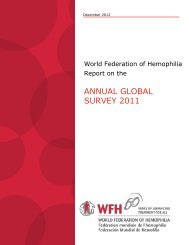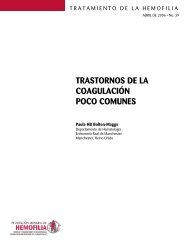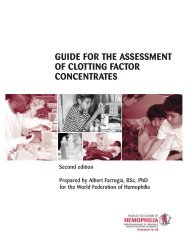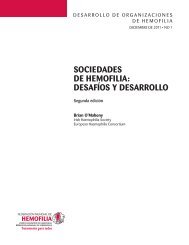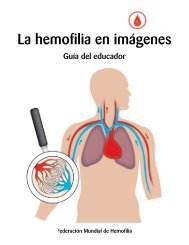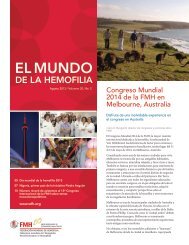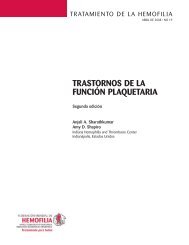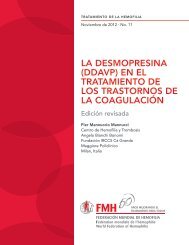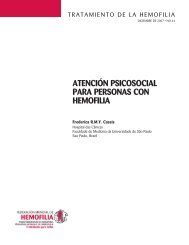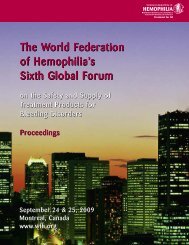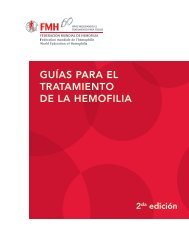ACQUIRED HEMOPHILIA - World Federation of Hemophilia
ACQUIRED HEMOPHILIA - World Federation of Hemophilia
ACQUIRED HEMOPHILIA - World Federation of Hemophilia
- No tags were found...
Create successful ePaper yourself
Turn your PDF publications into a flip-book with our unique Google optimized e-Paper software.
4Treatment <strong>of</strong> <strong>Hemophilia</strong> No. 38There are published case reports <strong>of</strong> venous and arterialthrombosis associated with both bypassing agents,although the risk is arguably lower with recombinantactivated factor VII [8,9]. It is difficult to quantify therisk in the light <strong>of</strong> such isolated case reports but cautionseems warranted in the treatment <strong>of</strong> patients with documentedcardiovascular risk factors. As mentioned above,tranexamic acid should not be given in conjunction withFEIBA.Clinical trials are currently underway to determinethe efficacy <strong>of</strong> recombinant porcine factor VIII in bothcongenital and acquired hemophilia. Its use is based onthe rationale that the structure <strong>of</strong> porcine factor VIII issufficiently similar to the human form to have some hemostaticeffect, but sufficiently different to be less susceptibleto inactivation by circulating antibodies.Suppression <strong>of</strong> inhibitor formationWhile hemostatic agents are administered to controlactual bleeding episodes, some form <strong>of</strong> immunosuppressivetreatment also needs to be given in order to suppressproduction <strong>of</strong> the underlying inhibitory antibody. It isrecommended that immunosuppressive therapy be initiatedas soon as the diagnosis <strong>of</strong> acquired hemophilia isestablished [2,5].The usual treatment involves administration <strong>of</strong> prednisolone(prednisone) at a dose <strong>of</strong> 1 mg/kg combined withcyclophosphamide 50-100 mg/day orally. Azathioprineis an alternative immunosuppressive agent. Treatmentshould be continued for up to two months, with regularreview.Most patients will respond well to such a combination<strong>of</strong> treatment. However, relapse is not uncommon oncethe drugs are stopped or the dose reduced. Patientsshould be followed up for at least one year after treatment.Monitoring <strong>of</strong> the APTT alone is usually quitesufficient if more sophisticated laboratory facilities arenot available [5]. A relapse rate <strong>of</strong> 20% was observed inthe U.K. cohort after a median time <strong>of</strong> 7.5 months (range:1 week–14 months) [2]. This is potentially problematicas it is not feasible to continue this treatment in thelong-term. One option is to use periodic pulses <strong>of</strong> steroidtherapy to maintain a satisfactory factor VIII level, butthe use <strong>of</strong> other immunosuppressive agents should alsobe considered.It has become clear in recent years that rituximab may bea valuable agent in managing acquired hemophilia [10].This anti-CD20 monoclonal antibody is primarily used inthe management <strong>of</strong> lymphoma because <strong>of</strong> its affinity forB lymphocytes. However, it has been successfully appliedin the management <strong>of</strong> various autoimmune conditions,including autoimmune thrombocytopenia.The usual treatment regime involves four separate intravenousinfusions <strong>of</strong> 375 mg/m2 each, administered atweekly intervals. It is generally well tolerated and a clinicalresponse is typically seen within a week <strong>of</strong> the first infusion,with a rise in factor VIII level and a correspondingfall in inhibitor titer. However, rituximab is not licensed byany <strong>of</strong> the major regulatory authorities for the treatment<strong>of</strong> acquired hemophilia and its <strong>of</strong>f-label use to treat thiscondition is likely to need prior approval in many institutions.There is now general consensus that the use <strong>of</strong>rituximab should be considered in cases where patientsprove resistant to first line therapy or in patients in whomsteroids and/or cytotoxics are best avoided. Some groupsnow take the view that the use <strong>of</strong> rituximab should alsobe considered as initial therapy in cases where the initialantibody titer is high.A course <strong>of</strong> rituximab is likely to prove much cheaperthan extended treatment with bypassing agents. A significantrebound with high factor VIII levels has been seenin some patients who have received immunosuppression.For this reason, international guidelines recommend thatconsideration be given to thromboprophylactic measuresin vulnerable immobile patients [5].Mycophenolate is another immunosuppressive agent thathas been recently reported to be both effective and welltolerated in a small number <strong>of</strong> patients with acquiredhemophilia, in whom other treatments do not work. [11].Its use should be regarded as experimental for the timebeingand considered only in patients who do not respondto conventional treatment.Cyclosporin has also been used in several cases [12], andappears effective particularly when systemic lupus erythematosusis the underlying disorder. Long-term treatmentwill require appropriate monitoring <strong>of</strong> plasma levels inorder to minimize toxicity. Cyclosporin is contraindicatedin renal failure.



